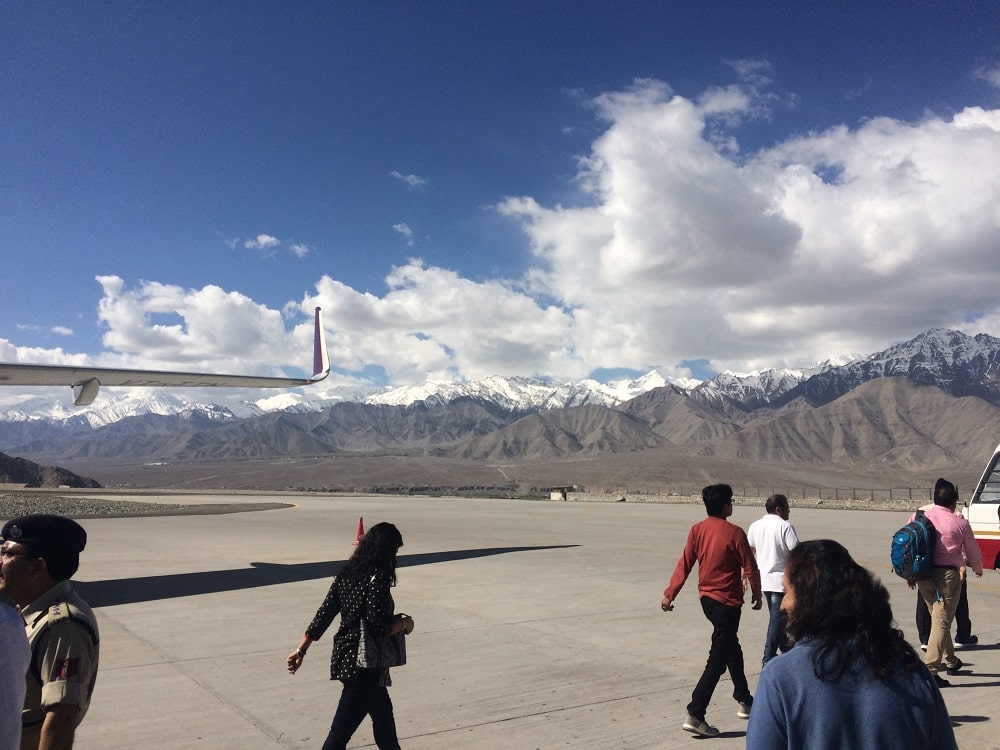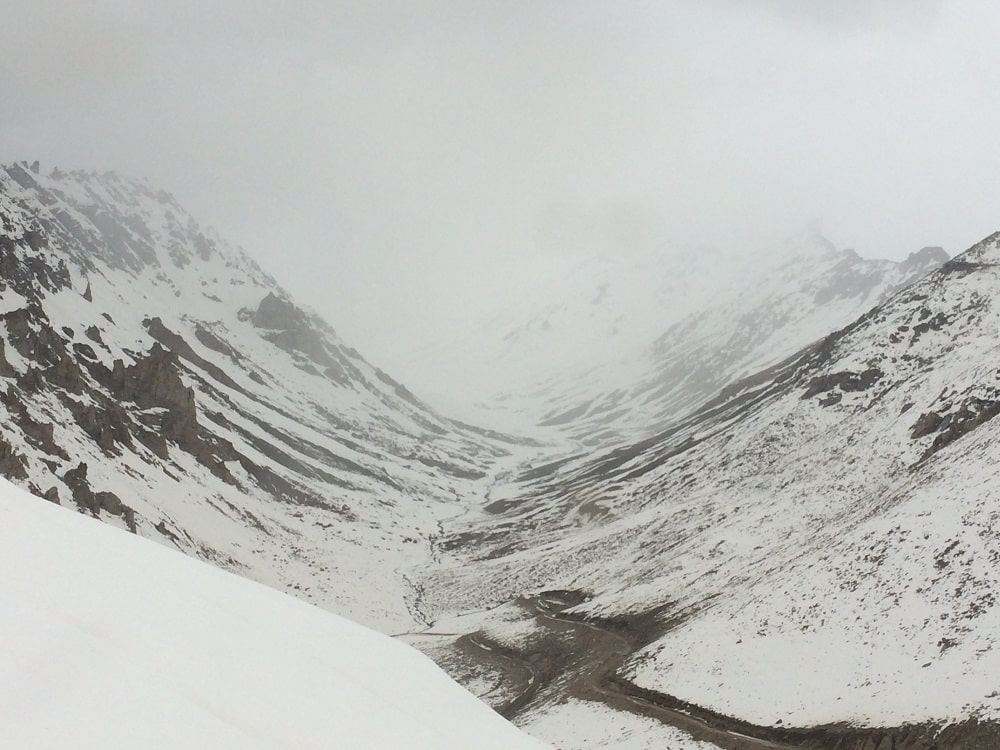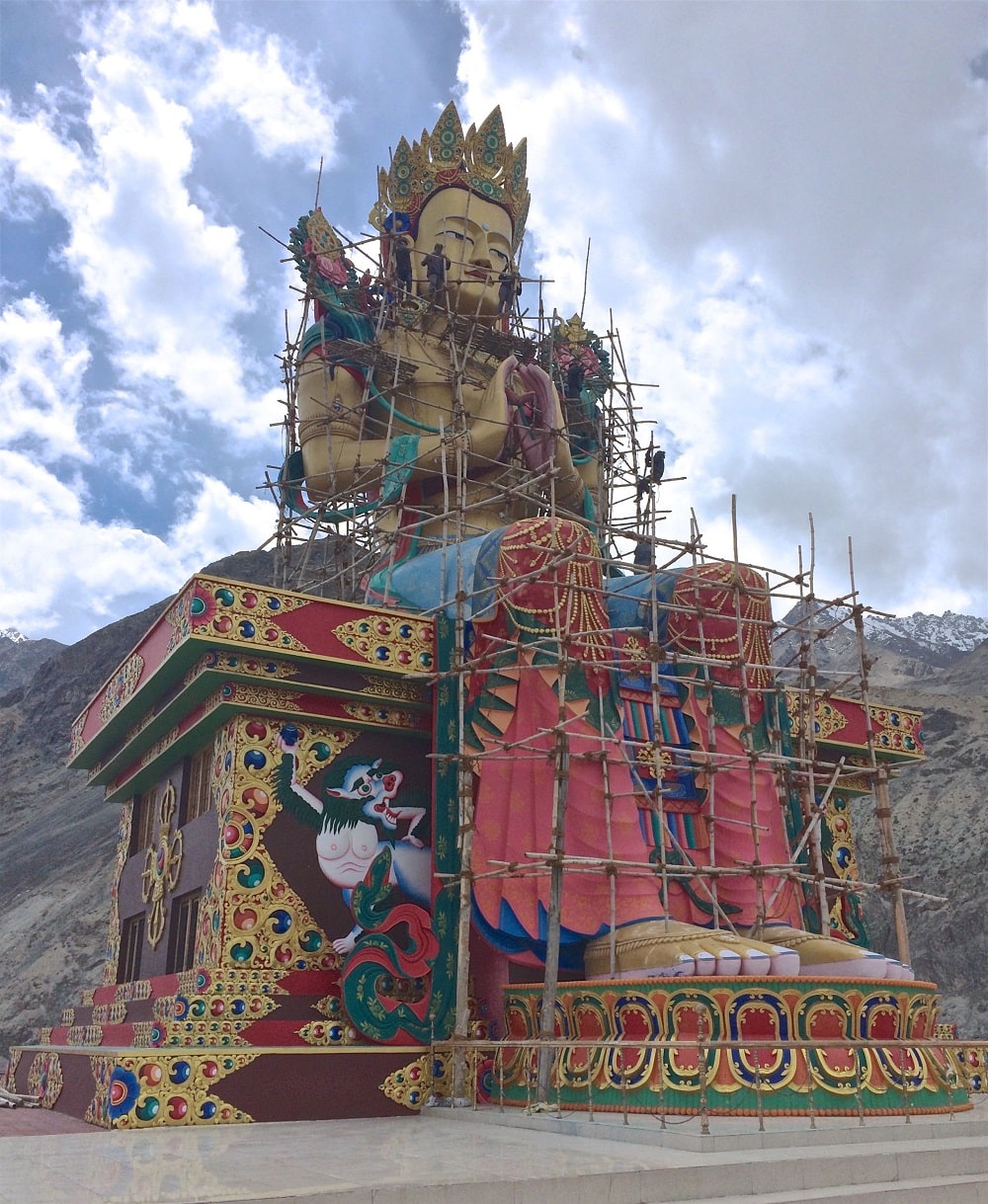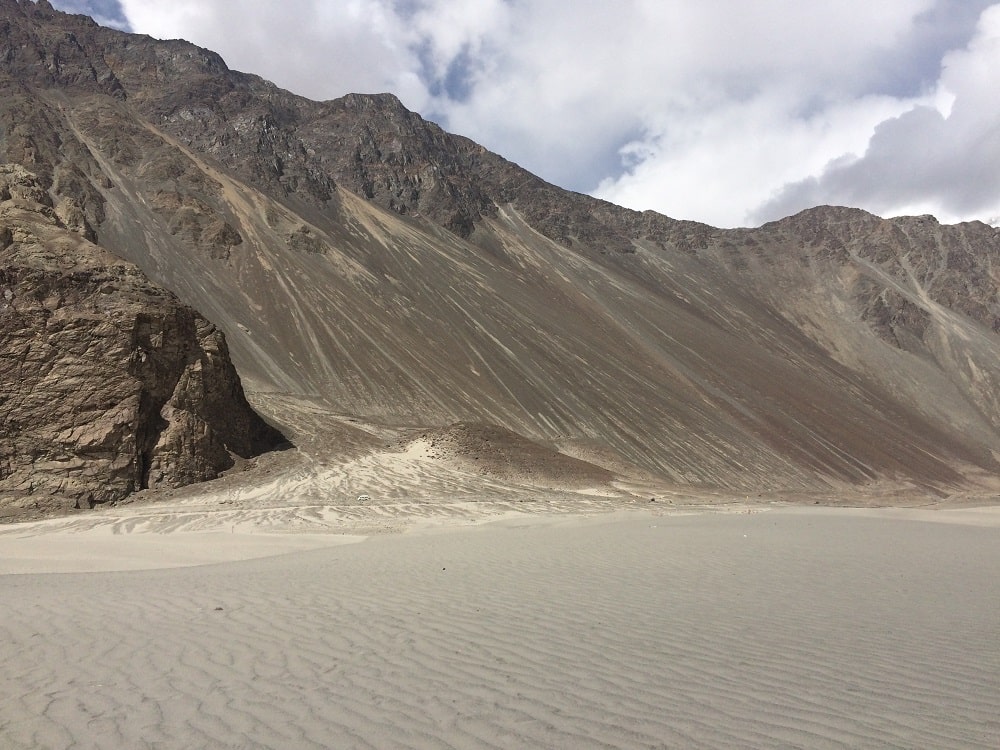‘Your first two days will go in acclimatization.’ was the warning given to me by my friend who had recently returned from Leh. ‘You will feel nauseous and possibly dizzy so definitely carry Disprin and Crocin. You smoke? Yeah, it may be three days then.’ This was not what my excited ears wanted to hear after having seen his picturesque photo album of selfies with snow-covered mountains, pristine lakes, and golden monasteries. ‘The landing strip at the airport is absolutely horrible so be ready for the train wreck of landings!’ Although his commencement of the journey began with more criticism than praise, when I asked him if it was all worth it in the end, he smiled and said that it was ‘life-altering.’

Image: Landing at Leh
When the hyperbolic advertisements of travel agencies scream ‘Don’t go abroad, India has it all!’ with respect to Leh they’ve genuinely got it right. Leh can’t offer you the wine, cheese, or chocolate that Switzerland can but it can definitely offer you sceneries as good if not better. Whether your in the main city or on a route to one of the adjoining valleys, a snow-capped mountain is never too far from sight. From one of the world’s highest motorable roads (Khardong La Pass) to the historical Hemis monastery; Leh is as much a treat for the eyes as it is food for the soul.
The Mountains of Leh
If the mountains call to you, the two iconic passes are Khardong La and Chang la which go towards Nubra Valley and Pangong Lake respectively. Though driving on these passes is never easy, be sure to take out your DSLRs for shots of a lifetime. The sights are simply breathtaking. The air does get thinner as you ascend on the passes but don’t worry the army camps set up on the highest points are always happy to lend you some oxygen as well as tea and Maggi to keep your spirits up.
Driving on these paths however is magnificent. You can admire God’s landscaping skills in all eternal glory. The combination of the clouds, sunshine, snow, and rock makes for a view that is unmatched to the naked eye. The Chang La pass leads to the now infamous Pangong Lake which has been immortalized on screen by many Bollywood movies including the blockbuster ‘3 Idiots’. Remember the ending scene when Kareena runs towards Aamir along the shore of a large body of water? Yes, that’s Pangong Lake. Tourists can find a yellow scooter with a red-helmet parked along the shore and take a selfie with the same for a mere Rs. 100.
The lake is considered holy by the locals which makes bathing or washing objects in it strictly forbidden. This has ensured it stays pristine despite the increasing number of visitors annually.

Image: Pangong Lake
Even though over 60% of the naturally occurring endorheic lake resides in the territory of the People’s Republic of China; its name has been given by the local Tibetan inhabitants of the Indian side. One of the unique features of the lake is that is freezes completely in the winter months despite being saline water. Migratory birds such as the Bar-headed goose and Brahmini ducks visit the lake during the summer months.
Standing at a mighty 18,380 feet, the Khardong La pass connects Leh to Nubra Valley. It was once the world’s highest motorable road. Foreign nationals are required to get a ‘Protected Area Permit’ while Indians need an ‘Inner Line Permit’ to visit the valley. This drive too is full of wonderment. Along with the breathtaking mountains, you may also run into a herd of Yaks and Tibetan Wild Ass herded by the locals.

Image: View on Khardongla Pass
In Nubra lies the town of Diskit and in it, the famous Diskit Monastery. The Monastery is landmarked by a 50-feet tall Maitreya Buddha statue making it easy to spot. Founded in the 14th century by Changzem Tserab Zangpo, it belongs to the Gelugpa (‘Model of Virtue’ in Tibetan) or ‘Yellow Hat’ sect of Tibetan Buddhism.

Image: 50 Foot Buddha at Diskit Monastery (Under Construction – Present-day completed)
In one section of the structure is a hall where encased in glass are the various deities worshipped by the sect’s followers. Amongst them are Shakyamuni Buddha and Guru Padmasambhava. Now Shakyamuni Buddha or Gautama Buddha; we are all familiar with but it was this other figurine, ‘Guru Padmasambhava’ that caught my eye. I felt I had seen him before and realized my hunch was right. A large statue of his stands in the even more famous ‘Hemis’ Monastery in Leh. One thing that perplexed me though was his facial expression. Unlike the others who wore expressions of peace and tranquility, Padmasambhava’s countenance was one of the aggressions.
Perplexed, I asked a monk why this was so. ‘Padmasambhava wasn’t an ordinary Guru. Before he became a noble teacher of the order he practiced Tantrism. When he first visited Tibet, he exorcised many demons in the land that were preventing the construction of the monastery. While his contribution made him revered; his deeds earned him a reputation of being an exorcist of fearsome native Tibetan demons. That is how he has been portrayed here’ the monk explained. Impressed by his words I began praising him for his vast knowledge; to which he simply pointed to the placard placed in a corner of the encasing itself. It contained the exact same information that he has said verbatim. Feeling foolish, I excused myself. As I walked away, I could have sworn I saw him laughing to himself from the corner of my eye.

Image: Statue of Guru Padmasambhava along with zoomed-in image of the description
Apart from the Monasteries, one can even take a ride atop the famous two-humped Bactrian Camels that can be found in the vast stretch of sand dunes. The tribesmen rely heavily on tourism for their income so don’t feel cheated if the asking price appears too high. After all, it is a seasonal business and they have many mouths to feed. For the ride itself, the only advice I can give you is to be sure to hold onto the reins tightly! Apart from the rides, the sand dunes are yet another mesmerizing sight to behold.

Image: Sand Dunes in Nubra Valley
Upon your return to the main city, one of the shorter excursions worth taking is the tour package offered from Leh to Sangam Valley. This excursion includes stops at the Hall of Fame, Spituk Monastery, Gurudwara Pathar Sahib, Magnetic Hill, before finally arriving at Sangam Valley. It is a full-day tour which includes a pick-up and drops service from your hotel and I highly recommend you go for it. Each stop has its own flavor.
The ‘Hall of Fame’ is a museum constructed and managed by the Indian Army commemorating the soldiers who have laid down their lives in service to the nation primarily during the Indo-Pak wars. Along with the arms and ammunition used during the Kargil dispute, one can also see the letters written by soldiers to their families before going to war. The bravery shown by them is tremendous it evokes a great sense of pride to anyone who reads them. The museum also has a section that tells you about the history of the Leh-Ladakh region itself. You can even have your picture clicked in a local Ladakhi outfit! Be sure to purchase a memento from the cute souvenir shop on your way out as all earnings go to the Army!
Said to be the home of over 100 monks, the Spituk Monastery is located atop the hill about 8 km from Leh. Constructed in a series of steps, tiers, and Gompas, it is famous for its mesmerizing views of the Indus river. One of the unique features of the monastery is the large statue of Goddess Kali that it houses. Though the main monastery itself has many statues and pictures relevant to Buddhism; it was this cave that caught my attention. The surge of energy felt within my body upon sitting in silence for a few moments was enough to keep me awake till 5 AM the next day. The statue itself is located inside a cave and the whole aura of the place feels like one that is surrounded by serenity and a deep kind of power. Almost as if a giant protector sleeps silently in the mountain and this one cave is your vantage point to look upon it.
Another destination of religious significance on this tour is Gurudwara Pathar Sahib. Constructed in honor of Guru Nanak or Nanak Lama as the locals call him; it houses the stone in which one can see the outline of a person sitting in meditation. The outline is said to be that of Nanak himself inviting many devotees annually to witness the miracle of faith. There is also langar that takes place here offering food and respite to all irrespective of caste, creed, or religion.

Image: Magnetic Hill
Magnetic Hill is a minor tourist attraction on this route where the driver took great pride in showing us how despite turning off his automobile, the vehicle moved uphill on its own due to the magical magnetic power of the hill. Thankfully this is one of those mysteries that modern-day science can explain. The place is an optical illusion as the asphalt appears to be uphill due to the landscape but is in fact downhill. Knowing the science however is not half as fun as being fooled into believing something magical about the place.
The last and final stop of this tour is Sangam Valley. As the name suggests it is the meeting point of two rivers – Indus and Zanskar. One can see the difference in the colors of the two rivers as they flow into each other to form one. The mountains in the backdrop provide for sights that are awe-inspiring.

Image: Sangam Valley – The meeting point of Indus & Zanskar
If simply taking in the sights isn’t enough for your adventurous mind you can even avail the option of rafting in the water although the rapids aren’t fast flowing like in Rishikesh so it feels more boating than actual rafting.
The hotel I stayed at in Leh is called ‘Yarab Tso Hotel’. Located just outside the main city, the staff undergoes regular rotation as the hotel business there is seasonal. The very accommodating young and frankly inexperienced owner Tenzin makes up in energy and smiles what he lacks in professionalism. His brother, also Tenzin, runs a hotel with the same name in Nubra Valley.
It’s almost as if they are trying very hard to be twins. But the Leh establishment is far more equipped to handle tourists than the Nubra one. While Nubra has a more Airbnb/homestay like feeling; the Leh outlet functions as a proper commercial outlet. Each has its own charm. The brothers being locals and having grown up there usually give you the best advice on how best to go about your trip depending on the number of days you have. Far better than any ‘Lonely Planet’ or remarks on Google can. They have a well-established network with the travel guides and taxi-services so it’s easy for them to arrange any excursions for you.
When in the main city one destination definitely worth a visit is the ‘Ancient palace’ or as the locals call it ‘City Palace’. Built in the 16th Century, the palace is nine stories high and provides a view overlooking the entire city. It was once the highest building in the world in terms of altitude from sea level. Post the Archeological Survey of India claiming it as a protected monument, the condition of the palace has become much better than what it once was. Now with guards, CCTV cameras, a proper ticketing system, and guided tours, people who enter are monitored and anything out of the order is not tolerated.

Image: View of the city from atop the palace
With the snow-capped mountains in the distance, the barren desert-like mountains nearby, and the city right underneath, one truly does feel like a king staring the layers of change in topography below. There is much in the palace to give you insight into the history of the Namgyal Dynasty and the wars fought in these lands. Even if you read the hoarding outside before entering the palace it proves to be enough honestly.
Before your trip comes to a close, a must-see destination is the grand Hemis Monastery. This place is a ‘wow’ for multiple reasons. Unfortunately, they do not permit photography so what you see will only stay with you in memory but believe me, these are memories worth creating. From the huge statues of Guru Padmasambhava and Lord Buddha in the grand main hall to the murals inside depicting the various gods and battles of good and evil to the spacious open courtyard surrounded by mountains on all sides – Hemis is another experience.
They are well equipped to handle tourists and the little children monks are always full of smiles and curiosity seeing new city travelers venture in. Some judge them as lost souls while some are friendly and intrigued by their outfits or technology and are usually too shy to approach you and simply giggle at you from a distance. Even though the vibrations and surge of power one feel from within while sitting in the grand hall are tremendous; it is not however the best part of the Monastery. The real magnificence lies underneath in the basement where the museum is. Telling you all about the history, culture, and festivals of the region along with the grand legends and ornaments used by the sages – the museum is like walking on the timeline of Hemis.

Image: Hemis Monastery Description
Post the tour, you feel convinced that in some past life you were here and that is why your karmic connection is so strong. Almost as if you were destined to visit there someday and that it is no coincidence you are here now. The deeper mysteries of life will engulf you and leave you with a taste of what it means to feel complete from within.
I remembered my friend’s words ‘life-altering’ and finally understood what he meant. I knew the journey was at an end and the busy soul-sucking streets of the city called me. Unpaid bills and pending salaries would greet me as would my friends with whom I’d indulge in alcohol and cigarettes to get away from the stressful hectic lifestyle. Harming my precious gift of a body in the pursuit of mental peace. But the inevitability of it all didn’t seem to pull me down as badly as I thought it would. I knew now that it wasn’t all that defined ‘me’. Leh had shown me other perspectives of what it meant to be present in the grandeur of life and the lessons learned would forever be a source of joy and peace.
